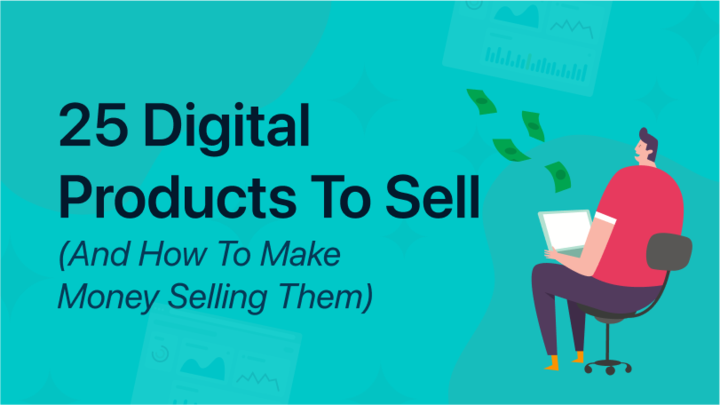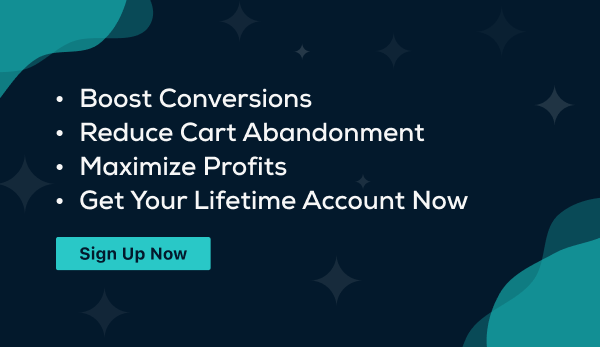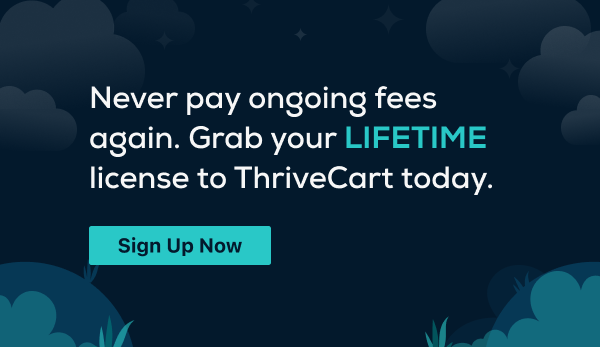If you’re in the market to create a sustainable, low-effort, and high-profit revenue stream for yourself, you’re in the right place.
Digital products offer exceptionally high-profit margins in comparison with those earned by physical products. With their low production cost and general ease of delivery, digital products such as online courses, eBooks and guides, and graphic files provide a huge financial opportunity to content creators.
In this guide, you’ll discover the most profitable digital products on the internet, how to get started selling them, and some tips on how to boost sales on your best digital products.
Spoiler alert: one of the best ways to do that is to use advanced sales funnels that help users complete the purchase process. If you wanna skip right to the good stuff, go see how ThriveCart can help grow your online sales.
What are Digital Products?
Digital products are products you can sell and deliver online, like instructional online courses; coaching and how-to videos; eBooks and reports; artworks and graphics; music or audio files; and more. Much of the online sales process can be automated, so your biggest effort lies in creating your digital goods. After building your website, listing your products, and implementing a marketing funnel that drives consumers or other businesses to your products, the entire sales and fulfillment process can happen on its own (and we’ll show you how).
Pros & Cons of Selling Digital Products vs Physical Products
When compared to physical products, starting a business selling digital products is significantly easier. Digital products are typically low-cost to produce, and once established, they’re a low-touch/low-effort sales vehicle that’s perfect for generating passive income.
Selling digital products continues to be a popular option for entrepreneurs and businesses of all sizes:
- Many beginners start selling digital goods as a side hustle using online marketplaces.
- Small businesses and business owners generate additional income by selling digital products.
- Large enterprises can build an entire business model based on digital goods and services.
Advantages of Selling Digital Products
Compared to physical goods, the advantages of selling digital products include the ability to update or edit products quickly and easily, less competition in the marketplace, high profit margins, and no physical inventory to manage. You also don’t have to worry about supply chain problems that continue to disrupt the eCommerce world for physical goods. With instant delivery and payment, sellers can scale businesses without significant additional costs.
Many online services also establish subscriptions, which leads to monthly recurring revenue (MRR).
Disadvantages of Selling Digital Products
When creating and selling digital products, it’s all up to you. You need to stay ahead of the trends in what people want, or what they need to know, and produce high-quality digital products to meet that need. You have to be informed, innovative, motivated, and scrappy. To say the least.
Add to that, in many cases (like for affiliate marketers, eBook authors, and course creators) you will be your own brand. Your topical expertise, opinions, and even personal values will all impact the fate of your business … so you must be careful with your personal branding and the image you present online.
Finally, as is often the case with artists and content creators, you may find that your audience doesn’t understand the effort that’s put into researching and creating your products. For this reason, many sellers of digital products find that there’s a certain amount of customer education that must be done in order for them to appreciate your pricing model.
5 Steps to Start Selling Digital Products
Whether you choose a popular digital product idea or have a new idea, the importance of research and planning cannot be overstated. Creating and refining digital products can be a lot of work. Before you spend the time and money doing so, you need to make sure there is a market for your product and a market opportunity.
There are five key elements to start selling digital products in your online store. Let’s take each one step-by-step.

1. Research Digital Product Ideas
You can start by brainstorming ideas for your online business while keeping a few key strategies in mind.
Identify Market Gaps
Look for a need that is not currently being filled by existing products or ways you can enhance existing products to provide a competitive advantage. A good place to look is customer feedback on online marketplaces for existing products. Often, you can find where customers believe current products fall short to help you generate ideas about what you can do better.
Look at Industry Trends
You also want to focus on forward-facing ideas. The last thing you want to do is invest in developing digital goods that are no longer in demand. Stay on top of industry trends in the marketplace, and keep an eye on what bloggers and industry influencers on social media are saying. As hockey superstar Wayne Gretzky once said, “skate to where the puck is going to be, not where it has been.”
Play on Your Strengths
Think about what knowledge, skills, or experience you have that you use to help others. Based on your experience, can you create a digital product that adds tangible value to your customers? Can you teach someone how to do something, produce unique products, or add to your existing business?
2. Define Your Target Audience
You also need to define exactly who your digital products are targeting. It makes a big difference when you are developing and marketing your products or services. You are going to target a senior business executive far differently with your digital marketing than you would a college student on TikTok.
Build Buyer Personas
It’s always a good idea to develop buyer personas. This is a semi-fictional representation of who your best customers will be based on how they will benefit from using your digital products. Your buyer personas should include:
- Demographic research, including age, education, job title, income levels
- Psychographics, such as attitudes, beliefs, and motivations
- Goals and pain points they are trying to solve
- Interests and habits
All of this information helps you focus your products and marketing by providing a mental image of who you are trying to reach. You can better personalize your outreach via an email list, blogs or content marketing efforts, paid advertising, and search engine optimization (SEO) to attract buyers.
Conduct Market Research
You need to understand your potential market and consumers. Buyers must have a need for what you are selling, the motivation and ability to buy, and the belief that your product will solve their problem or enhance their business or life.
Evaluate Competition
Before you commit to launching new products, you need a firm grasp of the competitive environment. If you have a revolutionary product, it is easier to distinguish yourself, but you may spend more time having to explain the value. If you are entering a crowded marketplace, you have to think about what makes your products stand out from the pack.
3. Develop Your Digital Product
You must have a high-quality product if you want to generate significant revenue. However, you must also differentiate yourself from any competitors as well.
Develop Your Unique Value Proposition
A unique value proposition (UVP) is a way to explain to potential customers the benefits and value of what you are selling. You must be able to succinctly tell potential buyers what they get when they buy your products and what makes your digital goods a better value than those sold by your competitors.
There are typically five different ways to sell your UVP:
- Productivity: Help customers improve their output, get things done more efficiently, or streamline systems and processes.
- Profitability: Help customers save money and generate additional revenue.
- Problem-Solving: Help customers solve a particular problem.
- Convenience: Help customers achieve their goals more easily.
- Experience: Provide an exceptional user experience.
Identify Your Selling Strategy
Once you have landed on your UVP, you can also identify the best way to sell and market your product. By tailoring your UVP messaging in terms of your buyer persona, you can highly target potential consumers with personalized marketing that speaks to them and their needs.
Focus on User Experience
No matter how good your product or service is, if you fall short on user experience (UX), consumers may never buy. Companies that focus on the user experience in product design outperformed the S&P by 228%. This applies to everything about your product from design, implementation, and marketing.
Simple changes that improve the user experience can make a significant difference. When office supply store Staples rebuilt their website to improve the user experience, their online revenue jumped by 500%.
4. Create Your Online Store
Digital commerce accounted for more than $3.41 billion in sales in 2022 and continues to expand at a rate of more than 12.5% annually. Altogether, the sale of digital goods and products made up about a third of the global e-commerce marketplace.
There are multiple places to sell digital goods and services online, but the best option is to utilize your own website. There, you’ll have full control over the user experience and what other products are – or better yet, are not – shown alongside your own. You’ll control your brand, gain better margins from each sale, access cross-selling and up-selling opportunities, and be able to create marketing campaigns to drive traffic.
Most digital product creators find success on WordPress, which makes it easy to build a site, add your products, and market them. For subscriptions, online courses, and affiliate marketing in particular, you will want to take a close look at ThriveCart to power your conversions.
5. Advertise Your Digital Products
Even with a great product or service, attracting, selling, and retaining customers is key to success. There is no shortage of ways to advertise and market your products, including:
- Developing email lists
- Utilizing social media
- Partnering with industry influencers
- Developing affiliate marketing partnerships
- Running targeted ad campaigns
- Content marketing
Managing Customer Acquisition Costs
It’s one of the biggest challenges in any business. If the cost of acquiring customers is higher than what you can make by selling your products, you cannot build a sustainable business. It is crucial to track the performance of all of your advertising and marketing efforts to determine what produces a reasonable ROI for your investment.
The 25 Most Profitable Types of Digital Products to Sell Online

Online Courses, Tutorials, & Webinars
Digital product ideas include:
- Online courses and training programs
- How-to videos and tutorials
- Webinars
- Podcasts
- Downloadable guides
- Videos
You can sell stand-alone products, but many online business owners and entrepreneurs create a subscription-based membership site. This creates a monthly recurring revenue which helps you grow your business and reduce your customer acquisition costs.
And when it comes to online courses, ThriveCart’s new online course creator tools allow you to create a series of digital courses which, that can then be featured as upsells or bump offers on related product sales pages. With ThriveCart: Learn, you can create unlimited courses, modules, and lessons–all for unlimited students, and all for free as part of your standard ThriveCart account.
Templates, Printables, & Digital Downloads
Digital product ideas include:
- Digital art
- Fonts
- Printable digital files, such as business cards or logos
- Design templates, such as digital birthday invitations
You can sell digital products or digital files to help others create products like T-shirt transfer designs or craft items. Another idea might be to create a SaaS platform that allows users to create their own products.
Professional Digital Deliverables
Digital product ideas include:
- Graphic design products
- Web design products/services
- Sound effects
- Stock photos
- Audiobooks
- Music
- Presentation templates
- Professional services
While there are sites that allow you to upload your graphic designs and earn a commission each time someone uses them, it comes at a high cost – both in terms of a commission fee and loss of control over your product. The better option is to create your own website of designs, audio, images, or templates, and collect the full sales price each time someone purchases your digital product.
Websites, Mobile Apps, & Similar Technologies
Digital product ideas include:
- Websites that you develop and sell
- Website plug-ins and add-ons, such as chatbots or appointment schedulers
- Mobile apps
- Email marketing templates
- Downloadable software like productivity tools, databases, communication tools, or any other software you invent to solve a problem
- Automated lead generation and marketing funnels
These products can help others start up their business, such as creating full-scale websites on WordPress, creating DIY templates, or adding functionality for customer websites.
Tips for Boosting Your Digital Product Sales

As you can see, there are multiple steps involved in finding, creating, marketing, and selling digital products. Finding the right products and niches, developing your value prop, lining up your sales channels, and marketing your products are all crucial parts of the process.
Many sellers, especially those starting out, often forget to also focus on creating a seamless experience that makes it easy to acquire buyers and get them to convert. The best online shopping experiences remove friction from the buying process. They establish a clear and intuitive path for shoppers and eliminate any unnecessary steps or hurdles that can lead to cart abandonment.
Here are a few tips that can help you significantly boost sales for your digital products.
Remove Friction from the Buying Process
There’s nothing more frustrating than convincing someone to put your products in their online cart and then not converting them to customers, but it happens all the time. Globally, cart abandonment rates hover at nearly 80%—and it’s even higher in some industries.
Take a look at some of the biggest reasons consumers say they give up on their online purchases, and how you can prevent it:
- Being forced to create an account. Requiring users to create an account can be an unnecessary barrier in most online purchases. Instead, ask for a phone number or email address to send the receipt, purchase confirmation, tracking details, or online access information to … but don’t make them set up a password if you can avoid it.
- Overly complicated checkout processes. Generally speaking, you’ll want to keep your information fields to the minimum and keep mouse clicks to 2 or less. Making an online purchase shouldn’t feel like applying for a job with the Secret Service.
- Unexpected costs at checkout. Price transparency is huge for two reasons: It sets expectations when it comes time for payment, and establishes trust. It’s important to reveal “hidden” fees in advance, like shipping costs, licensing fees, or anything else that may be unanticipated by the buyer.
- Concerns about security. Online purchases have become the norm in today’s age, and online shoppers are getting savvy about what to look for when making a purchase. Make sure your website is secured with an SSL or TLS security certificate installed on your domain. If your website doesn’t already have an HTTPS domain, then this should be a priority.
Address these concerns intentionally and in advance, and watch as your conversion metrics begin to climb.
Use High-Converting Online Shopping Carts
By using a tool like ThriveCart on your website, you can streamline the checkout process while also significantly increasing your sell-through and creating additional profit boosters. For example, you can create:
- One-click upsell funnels
- Bump offers
- Trials
- Subscriptions
- Embeddable checkout pages on your own siteshopping carts
You can also apply intelligent business rules to automatically calculate and apply sales tax (if applicable), conversion rates, affiliate payments, and discounts. ThriveCart even lets you offer advanced options such as free trials, split-pay options, and coupon codes.
Optimize Your Sales Funnel
Sales funnels are highly effective for educating your audience about your product, building trust, and demonstrating value. But your sales funnel can do so much more if you’re strategic about it.
For instance, perhaps your current buyer journey looks like this:
- User clicks on a social post/advertisement and enters your site.
- They scroll through product offerings, and perhaps view a demo video, then click away.
- Targeted ads begin appearing in their browser.
- They’re reminded of your product, go back to your site, and put an item in their cart.
- Something distracts them from completing the sale.
- The user continues seeing targeted ads… and eventually they either buy, or cookies expire, and ads stop showing.
By using an advanced sales funnel, the buyer journey could look more like this:
- User clicks on a social post/advertisement and enters your site.
- They scroll through product offerings, and are encouraged to leave their email address in exchange for free tips or other useful content.
- All at once, the following actions start occurring in timed sequences–each with a CTA leading to your product page:
- Targeted ads begin appearing in their browser.
- They’re added to an email drip that shares product offerings and value
- They’re sent videos showcasing why others love your product
- After clicking any of those CTAs, the user goes back to your site and puts an item in their cart.
- Their shopping cart is user-friendly, making it easy to complete the purchase.
- Users can receive several upsell or downsell options before completing the sale.
- Those who hesitate can be presented with special offers.
- Those who abandon their carts receive automatic email follow-ups to complete the sale.
ThriveCart makes it easy to create advanced sales funnels that moves users from reviewing the product page to completing the purchase. With ThriveCart, nearly every part of your sales funnel is customizable. We’ve set up integrations that will work with almost any online platform, website, or social media platform. And we’ve enabled automation to help reduce cart abandonment through email reminders to complete purchases, including adding special incentives if you want.
ThriveCart provides the marketing tools you need to create high-converting lead magnets, sales funnels, landing pages, and checkouts, leveraging automation to generate revenue and grow your business. If you’re selling online courses or affiliate products, or if you just want to promote a few of your most popular SKUs, you should see what it can do to boost your conversions.
And, in fact, you can see for yourself! Learn more and signup for ThriveCart today through this special offer.






